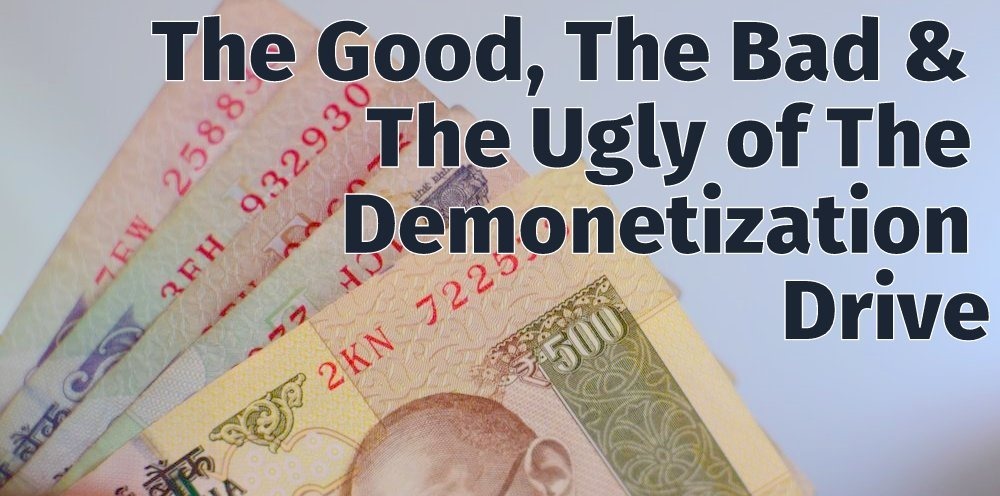The Good, Bad & Ugly Of Demonetization Drive – 3 Case Studies

On the night of November 8th, India witnessed a financial coup, the scale of which was unparalleled in the entire human history. Demonetization of 86% of floating currency in the market meant a huge transformation in the way businesses are being conducted in India. Push for 100% cashless transactions meant that age-old customs had to be destroyed, and new ways required to be learnt in order to conduct any type of business in the country.
As the demonetization drive enters 6th week, we present three aspects of this massive movement: The Good, The Bad and The Ugly.
No, we are not judging demonetization via these three case studies; but we are presenting an observation which can help the Govt. to decide the right course of action. And, it may give you a clearer picture of this movement, seen from the lenses of business and growth.
The Good: Amul Story
Amul, the dairy cooperative jointly owned by 36 lakh milk producers in Gujarat has adapted cashless mode in a massive way. Since November 8th, 5.4 lakh farmers have opened their saving accounts in various banks. With this, almost 18 lakh milk producers are now getting their money directly into their bank account.
As per RS Sodhi, MD of Amul, farmers are now saving a lot more, optimally planning their yearly financial goals, and with bank accounts, are able to get loans at a lesser interest rate. Before, loan sharks used to have a major influence in their financial world, as the farmers used to get stuck within their high-interest trap, and ended up spending more money.
He said, “The response from farmers to open bank accounts has been immense. Earlier, they were spending money recklessly and had not developed the habit of saving. With their bank accounts now being operational and a withdrawal limit in place, milk farmers have seen an improvement in their savings too. Also, they can look forward to applying for loans once they built a supporting credit history,
And, as per Amul’s own data, there has been absolutely no reduction in their sales, except few products of ice-cream. Sodhi said, “On the sales front, there was a short-term impact on discretion products such as ice-cream. But there is absolutely no impact on sales of milk, butter and curd,”
Amul, which propelled India to become world’s largest producer of milk and milk products, is now making India a cashless nation.
Related: 9 Awesomely Positive Consequences Of Rs 500, Rs 1000 #CurrencyBan
Bill Gates, Sachin Bansal, Umang Bedi Hail #CurrencyBan As A Masterstroke
The Bad: Raymond Story
Raymond, the 91 year old behemoth of textiles and garments has said that post-demonetization, they have experienced 30% reduction in sales. As per CEO Sanjay Behl, 90% of the textile market is based on cash, and the sudden demonetization drive has left the industry crippled, and gasping for breath.
Interestingly, Behl also said that they are confident about stabilization of the market, as new currency is being introduced gradually, and people are opting for cashless mode of payments. However, the reality is that 30% of their products are not selling right now.
Raymond is sure that once GST kicks in, the situation will improve.
In the month of September, Raymond announced that 10,000 workers can be fired as automation is being introduced within their factories.
This is certainly one of those short-term bad stories, which resulted due to demonetization.
Related: Govt Launches DigiShala, A 24X7 TV Channel to Teach Cashless/Digital Initiatives!
The Ugly: Foxconn Story
Due to demonetization, sales of electronics gadgets and mobile phones have reduced to some extent, and the ugliest impact can be seen at Foxconn, where nearly 2000 workers have been asked to go on a paid leave for 2 weeks.
As per insider sources, if the situation doesn’t improve in the next week, these employees can be asked to resign as well.
Nearly one-fourth of the overall workforce of Foxconn is getting hit by the demonetization move, and this is the ugliest story so far.
As per another set of reports, sales of mobile phones have been reduced by 50% post-November 8th, and the current market of ‘Make in India’ handsets have shrunk to Rs 175-200 crore.
Besides Foxconn, companies like Lava, Karbonn, Intex have also either fired or forced paid leaves 10-40% of their entire workforce in India. Starting December 12th, Lava has temporarily closed down one of their major plants, and it employed 5000 people. Foxconn’s plant at Sri City in Andhra is now manufacturing only 1.2 million handsets a month, compared to 2.5 million capacity.
Reports are also coming in Micromax’s Rudrapur plant has been asked to slow down production.
The solution is clearly these two simple actions: Distribution of more currency in the market, and inspire, encourage buyers to go cashless.
Although this isn’t a depression, as our economy is going full guns to experience massive growth, but due to lack of cash in the market, and reluctance to go cashless, buyers have suddenly stopped spending money.
We will request the Govt. to look into these bad and ugly stories, and implement the best practices from the good stories to revive and re-energize these industries.

Whether it is a Management strategy or political influence
for the growth of industry